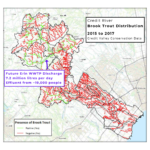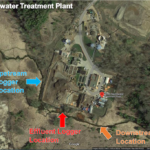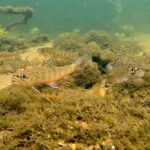MISCONCEPTION - ERIN WWTP will cool the West Credit River in the SUmmer
There is a misconception that the effluent from the proposed Erin WWTP will “help the West Credit River” by cooling it in the summer. This assumption is largely based on observations from the Orangeville WWTP that do not apply to the West Credit River. The ideal temperature for the West Credit River is 19 °C in summer months.
The Orangeville WWTP does cool the main branch of the Credit River in the summer but this should not be compared to the Erin WWTP and the West Credit River.

Location of Island Lake, the Orangeville WWTP and the Effluent Outfall Location in the main branch of the Credit River.
The Orangeville WWTP discharges into the main branch of the Credit River below Island Lake. Island Lake is a shallow man-made reservoir created in 1967 and heats up over the summer like any shallow body of water. The main branch of the Credit River receives warm water from Island Lake and has the same thermal behaviour as Island Lake. In the summer months the main branch of the Credit River below Island Lake does not support Brook Trout.

Orangeville WWTP Effluent Cools the Main Branch of the Credit River in the Summer
Daily Average Temperatures of the Orangeville WWTP Effluent and Main Branch of the Credit River Upstream and Downstream of the Orangeville WWTP in the Summer of 2021. Effluent temperature logger stopped recording on August 21 2021.
Effluent from the Orangeville WWTP is colder than the main branch of the Credit River at the effluent outfall site because the main branch receives water from Island Lake which is a warm water ecosystem with average daily summer temperatures around 22 °C. You can see this in the plot above where red represents the effluent temperature and blue the temperature of the Credit River upstream of the Orangeville WWTP.
A plot of all data related to the Orangeville WWTP from July and August is available at these links. JULY AUGUST
Compare the plot above from Orangeville and the main branch of the Credit River to the plot of the Acton WWTP and Black Creek. The effluent of the Acton WWTP increases the temperature of Black Creek because the effluent temperature (shown in red) is above the temperature of Black Creek upstream of the Acton WWTP (shown in blue).

A plot of all data related to the Acton WWTP is available at these links. JULY AUGUST
Black Creek is a coldwater ecosystem in the summer and the effluent is warmer than the upstream river. The effluent from the Acton WWTP increases the mixed river temperature.
The West Credit River is a coldwater ecosystem. The effluent data collected in the summer of 2021 shows that effluent from proposed Erin WWTP will be warmer than the river for almost all of the summer. Therefore, the West Credit River is likely to behave like Acton and not like Orangeville when effluent is added to the river.
The plot below shows the average daily temperatures in various locations of the West Credit River in the summer of 2021. While there are days in the summer with average daily temperatures above 19 °C the river recovers to colder temperatures after several days of elevated temperatures. The average over the summer months is below 19 °C making the West Credit River a coldwater ecosystem.

The West Credit River is a coldwater ecosystem with average summer temperatures below 19 °C. It is expected to be warmed by the Erin WWTP effluent as Black Creek is warmed by the Acton WWTP.
Click here to see a map of the data logger locations on the West Credit River.
The statement that the “Orangeville WWTP cools the main branch of the Credit River in the summer” is true but should not be applied to the Erin WWTP and the West Credit River. This statement is commonly used by proponents of the Erin WWTP to downplay or negate the potential thermal impacts of the Erin WWTP on the West Credit River.





